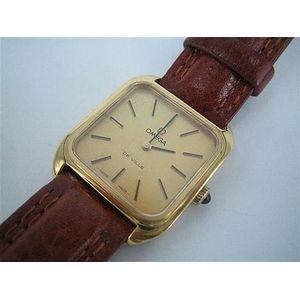Art Deco 9ct Gold Templux Wristwatch with Handley Case
You must be a subscriber, and be logged in to view price and dealer details.
Subscribe Now to view actual auction price for this item
When you subscribe, you have the option of setting the currency in which to display prices to $Au, $US, $NZ or Stg.
- Art Deco Period - The Art Deco period was a cultural movement that emerged in the 1920s and 1930s, and was characterized by its emphasis on modernism, luxury, and elegance. The name "Art Deco" comes from the Exposition Internationale des Arts Décoratifs et Industriels Modernes, a large exhibition held in Paris in 1925 that showcased the latest trends in decorative arts.
Art Deco was a reaction against the ornate and elaborate styles of the previous era, and reflected a new modern sensibility. It was characterized by streamlined, geometric shapes, bright colours, and the use of new materials such as chrome, glass, and Bakelite. Art Deco designers sought to create a sense of luxury and sophistication, often incorporating expensive materials such as ivory, marble, and rare woods.
Art Deco had a significant impact on a wide range of artistic fields, including architecture, fashion, graphic design, and interior design. Some of the most iconic examples of Art Deco architecture include the Empire State Building in New York City, the Hoover Building in London, and the Palais de Chaillot in Paris.
The Art Deco period came to an end in the 1940s, as World War II and changing cultural trends led to a shift in artistic styles. However, Art Deco remains an important influence on design and art, and continues to be celebrated for its modernist sensibility and glamorous aesthetic. - Bezel - On a clock or watch, the bezel is the metal frame into which the watch or clock glass is fitted. In clocks, the bezel may include a hinge and a flange, in effect a door to the face of the clock. In jewellery the bezel is a band of metal with a projecting lip that holds the gemstone in its setting.
- Lever Escapement - A lever escapement is a type of escapement mechanism used in mechanical clocks and watches to regulate the timekeeping of the movement. It was invented by British clockmaker Thomas Mudge in the 18th century and is now widely used in modern mechanical timepieces.
The lever escapement consists of three main parts: the escape wheel, the pallet fork, and the lever. The escape wheel is a wheel with teeth that is driven by the clock or watch's main spring or weight. The pallet fork is a two-pronged component that is positioned so that it can engage with the teeth of the escape wheel, and the lever is a small, L-shaped component that is attached to the pallet fork.
When the escape wheel turns, one of its teeth pushes against one of the pallet fork's prongs, causing the fork to pivot. As the pallet fork pivots, it releases the tooth and engages with the next tooth on the opposite side of the escape wheel. At the same time, the lever, which is connected to the pallet fork, rocks back and forth, allowing the escape wheel to turn at a regulated rate.
The lever escapement is prized for its accuracy and reliability and is commonly used in high-end mechanical watches. It allows for precise timekeeping by ensuring that the movement of the watch or clock is regulated and consistent, and its compact size makes it an ideal choice for use in small, portable timepieces.
This item has been included into following indexes:
Visually similar items

A lady's Omega 'De Ville' wrist-watch, gold-plated case, manual wind, baton numeral square dial

A vintage 9ct gold wristwatch, 15 jewel Swiss movement signed Marconi Rolex with guilloche sunburst dial, luminous Arabic numerals and hands, subsidiary seconds, curved glass Handley case, leather band buckle with Rolex logo, not working.

A 1960s Omega 'Seamaster de Ville' gents watch, silvered dial, date at 3 o'clock, gold filled case, Hirsch crocodile bracelet. Diameter case with crown 37 mm.

Art Deco C1929 14ct Mimo watch Co (Girard Perregaux) manual wristwatch rectangular silvered dial with chased case framing on leather strap
